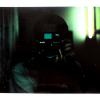Leaderboard
Popular Content
Showing content with the highest reputation on 04/07/2013 in all areas
-
I think there's two things going on here, the MoVi thing, and Laforet's "short", one is awesome, the other is incredibly terrible. This thing obviously has a lot of potential, it's a novelty and they're charging for that, realistically this thing could be sold for well under $5k. But they were the first to provide it at this level of completion and useability, so let them milk it while they can. Laforet's short however seems to me like a terrible demo. Most people have mentioned the out of focus and poorly framed shots, bad editing and poor filmmaking in general, most shots are totally unmotivated, and worse of all, there's nothing here in terms of camera movement that I haven't seen before. Watch a film like Hannah and and you'll find plenty of fluid steady shots, much better shot, so he missed his chance of showin off the specific skills this thing might have.2 points
-
nice toy... but not really new... gamechanger? for 15000$ + remote focus / iris / zoom system $$ + wireless video $$ + remote operator + focus puller + arnold schwarzenegger to carry this around.... well... all quadcopter gimbals are "inspired" by the flight head. and their own small version is available for some years now. http://www.portocam.com it`s just not small enough to carry it around by hand, but it takes on decent cameras.. and comes at a price... BUT, quadcopter gimbals are available from dozens of sources, the electronics became smaller etc.. i think this is a good "inspiration" for something you can build on your own for a fraction of the price!2 points
-

Probably the best slow-mo footage I have ever seen - Phantom Flex 4K at 1000fps
Zach reacted to Andrew Reid for a topic
http://vimeo.com/63490371 Totally blown away by this. And it isn't just the slow mo - Imagine the kind of photography in terms of the stills you can get with this ultra high resolution, high speed cinematography. Congrats to Vision Research, AbelCine and the director Brendan Bellomo and DP Gregory Wilson.1 point -
Phantom Flex 4K revealed - 1000fps at full resolution
Zach reacted to NikolaOvcharski for a topic
Holy sh*t1 point -
SSD's cost around 150 euros and upwards for 250 GB, over 300 euros for 500 GB sizes. SSD's are the most rugged ones for sure. Hard disks are far more sensitive to rough handling and shocks than SSD's. However, they are the most sensitive when they are powered on. If you eject hard disks safely before powering off - hard disks park their mechanical parts (arms with read/write heads). When in parked state, hard disks can withstand quite a lot of shocks and rough handling. So, if you want lots of storage for a cheap price, hard disks are the way to go. If you want the absolutely best ruggedness but can survive on a bit smaller storage, SSD's will be the best choice. Depending on where you travel, you want to keep both SSD's and HDD's dry. In jungle-like humidity you really would want to have some kind of sealed box/bag with something that absorbs humidity, like silica gel. I've seen how bags get treated at airports, and would it be me, I'd be sure to keep the portable disk as hand luggage, wrapped in a sweater or so. Normal carrying like that in a backpack or so shouldn't be a problem if you aren't unusually careless about the bag. When it comes to the casings of the hard disks, I wouldn't care too much about if it is padded or not, that's mainly cosmetic. What I'd care more about would be the cooling properties of the hard disk case. According to largescale tests done by larger data centers, hard disks have the least amount of failure if they run at around 30-40 degrees celcius. Cooler or warmer running increases risks for failure. My personal recommendation for traveling storage on the cheap would be to get two portable hard disks, one for backup, then using same transporting & dry keeping for both of the disks. If they'd get banged around enough to break - you got a good chance that one of the disks survive at least. Hard disks are the same all around the world as well, so you'd easily be able to get a replacement for backup if one would break down. Also, any portable hard disk that has the right interface for your mac (USB/Firewire) will work, no real difference. My own solution is to get any cheap metal (better for keeping drives running cool) casing I can find for the interface I need (usb/firewire/esata), and then I drop in just a normal 3.5" hard disk. No reason for you to do it if you need a new case, I just do so because I usually have a lot of extra hard disks lying around.1 point
-
Not all steadicam builders and operators missed brushless technology. I'm part of a german open source community, testing and building brushless systems since a few months. Somebody there showcased a DIY gimbal that looks exactly like the handheld MöVI: http://www.imagebam.com/image/e4b9a5247306171 http://fpv-community.de/showthread.php?24682-MoVi-Freefly-Brushless-Gimbal-goes-Hollywood/page2 I did also notice how good this system is for handheld usage, though it is only 2 axis at the moment. But the third axis is on it's way: http://fpv-community.de/showthread.php?24620-Offizieller-Thread-Brushless-Gimbal-Controller-f%FCr-3-Achsen (...sorry, everything in German). I'm building a 2 meter crane version for my steadicam very similar to the Portocam or Steadicam Tango. Should be ready to show first results soon :). Once the 3 axis controller is available I'll add handles for handheld as well. Brushless systems are also great for shotmakers and car mounts like this guy shows: http://www.youtube.com/watch?v=wWRKXHPSCls.1 point
-
I find using a pistol grip with these cameras helps a lot, and pressing your face against the viewfinder I got this one http://www.ebay.com/itm/NEW-Authentic-P-C-Camera-DSLR-pistol-grip-handle-FREE-D-Ring-/1307438123511 point
-
The opening shots from the helicopter are jerky as shit and so is the cab shot that everyone is so gaga about. I don't get it. You need an army of people to use and operate the thing effectively, so it's not like you're showing up to a shoot by yourself and using this. The spiral stairwell case shot could have been pulled off flying a Glidecam and a DSLR upside down without a doubt. Even if it weren't possible, it's not like that shot was all that riveting staring at her out of focus shoulders while wobbling down the stairs with the camera operator's shadow coming into the scene(which happened a few different times). Vinny Minton would have absolutely gotten a smoother and more precise shot during the cab scene with a simple Glidecam. This blows away all of the footage shot with this "game changer" and it's a $500 Glidecam operated by one person - http://www.youtube.com/watch?v=_YvfX7D8MXI For tight spaces and some helicopter work (albeit the footage examples from the helicopter were quite poor at times), I see this as a useful tool. I would not call this a "game changer" and compare it to the level of game change that the 5D2 brought on, that is quite absurd.1 point
-

Something isn't right.
Tito Ferradans reacted to dahlfors for a topic
Tricking visual perception has been done a long time in art, and yes, how the human brain interprets visual information is a big subject. I'd recommend that you experiment in Photoshop with upscaling on some stills (a lot faster and easier to work on a still). Pick some sample stills that you can find, one squeezed anamorphic still and one normal still with no squeeze. Then use these techniques - I often use them myself in my design work if I for some reason have photos that aren't detailed enough: 1) Depending on the image, add one round of sharpening with smart sharpen at around 1.5-3.0 pixel radius, with amount around 5-15%, 2) Then add a second sharpening with 0.2-0.5 pixel radius at a bit higher amount, 15-45%. The values depends a lot on how it's going to be used, and the original resolution of the image. 3) If I want yet more perceived resolution I add one noise layer in overlay mode and tweak that to what I like. Since you do it for screen use, you use quite little opacity on the noise layer (how large of an opacity value you will use also depends on how much contrast your noise layer has). When working with print as output medium - you use far more noise (the print process hides most of the noise you add in fact). Experiment with different settings and put the images side by side to compare. You will notice that you can get a lot more perceived resolution when you sharpen the right way, add grain - and do only horisontal scaling as in the case of anamorphic... - Same methods can be applied for video as with the stills - the difference will be that your noise is animated and that you don't necessarily run two rounds of sharpening. These methods (except horisontal-only scaling as with anamorphic) have been used for print medium a long time. For print you can successfully scale upwards to 150-200% without much perceived loss of resolution, even more when it goes for billboards or something that will be viewed at a further distance. - Basically, most kind of grit / noise / dirt / distortion layers layered on top with a bit of opacity will increase the perceived resolution. In the early days of web design when high res digital photos were harder to acquire, people used scanlines so much for this reason - that it became a popular design style (similarily to this image: http://fc06.deviantart.net/fs70/f/2010/081/9/f/Labrador_Wallpaper_Scanlines_by_Red_Se7en.jpg). Scanned filmgrain or noise will be what you want for video. Similar methods for upscaling were previously commonly used for 3D animations to save on render time previously when hardware was a lot slower. Genuine Fractals was the name of a tool specifically made for upsizing, yielding even better results than traditional upsampling algorithms. These days it has been renamed "perfect resize": http://www.ononesoftware.com/products/perfect-resize/, but it's unfortunately not a plugin for video softwares and if it is used on video, it needs to be run frame by frame. With these upscaling methods you'll notice that upscaling can produce very good results. Thanks to anamorphic needing only horisontal scaling, end result is even better.1 point -

Anamorphic Field of View Test
Tito Ferradans reacted to dahlfors for a topic
You mean: RED One has a S35 sensor, while the 5d3 has a full frame 35mm sensor :) Comparison image here: http://www.eoshd.com/wp-content/uploads/2011/08/sensor-comparison3.jpg And regarding original poster: Yes, anamorphic lenses are made to squeeze the image as much over the whole lens. This means - even if you just use the center area of the anamorphic, it will squeeze in the image there as well - which you confirmed with your test. That the RED One S35mm sensor is smaller than a full frame sensor results in, means that you can use a wider taking lens than on the full frame 5Dmk3 without getting vignetting.1 point -
haha, love the gore!1 point
-
The cynicism is not very appealing guys. Regardless of what you think of the price, this idea didn't exist in the community before. Sometimes it takes 'advertising' to get the word out. I think Vincent is someone who shot with it and thought it worth shouting about. That is very different to advertising where someone is paid to shout about something usually mundane. If you heard of the MoVI style use of copter gyro gimbal tech before now, why aren't YOU shouting about it?1 point
-
This is rad. Nice!1 point
-
I think it would totally change the thousands of DSLR short films you see on vimeo these days. Instead of being shot wide open, with shallow depth of field and most of the important subjects out of focus, they would be shot wide open, with shallow depth of field, most subjects out of focus and badly framed and feature loads of smooth flying shots. Just joking here! Kind of...1 point
-
I hate it when they do (lame) product demos and call it short films, then it's neither one or the other in the end. This "short" was terribly staged, camera was all over the place, crossing the line shot after shot, poor composition... if they had just done an objective and carefully planned demo they'd have spent their money better, but I guess they were paying for the Laforet hype and publicity, not for a good short film. This equipment is welcome and I'm sure it will find its use, its price is not expensive for high end film making, but in order to be revolutionary as they're trying to make it, it would have to cost a fraction of that.1 point
-
Perhaps run a duplicate layer or two of the edit above the keyed one, and garbage matte out all but the logos. Do any any master grading on an adjustment layer above all of them...1 point
-
Just playing with these for about 3 minutes, I can see why it's often called "baby Alexa" UNGRADED ATTEMPT TO CREATE "ALEXA STYLE" LOOK1 point






